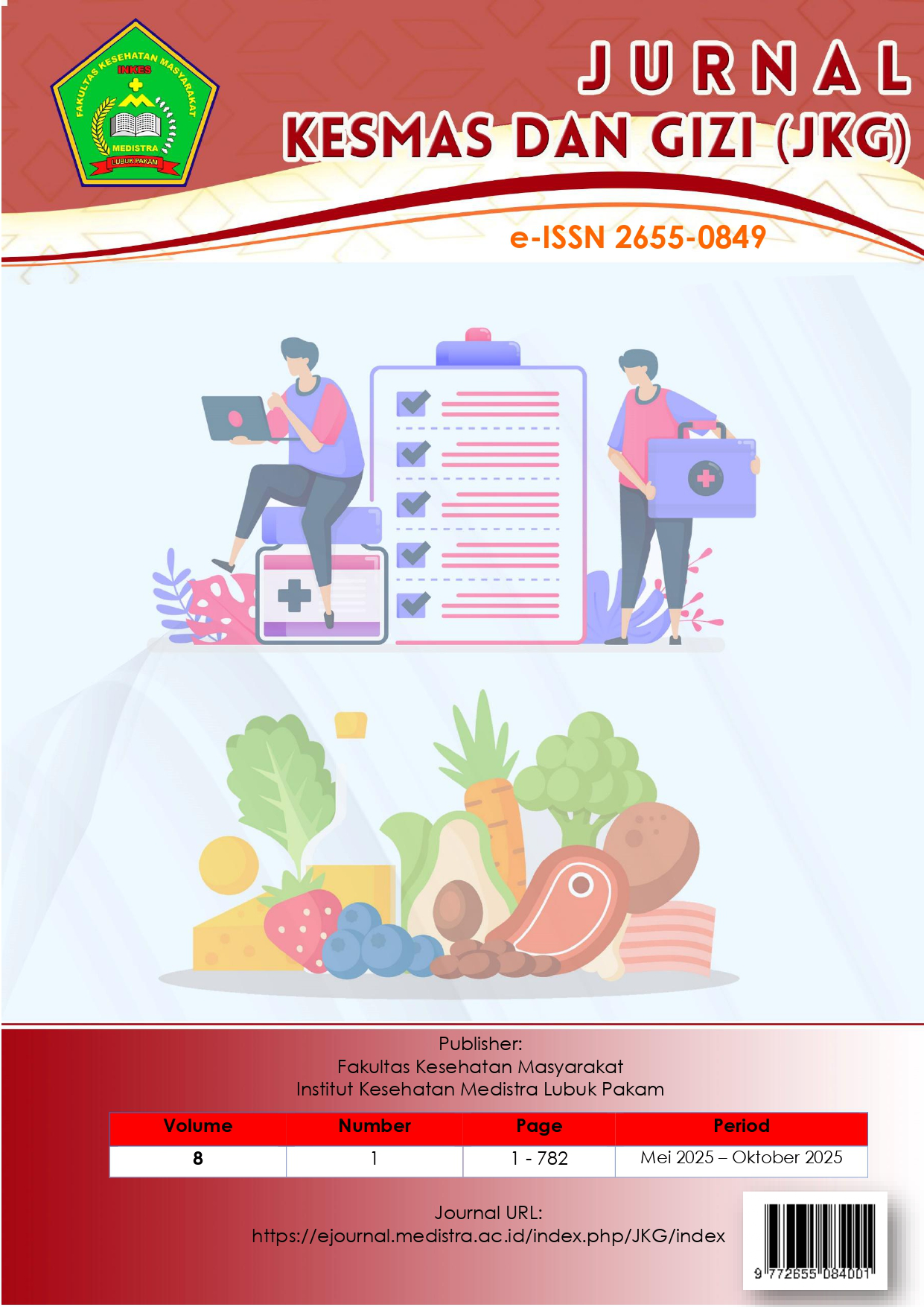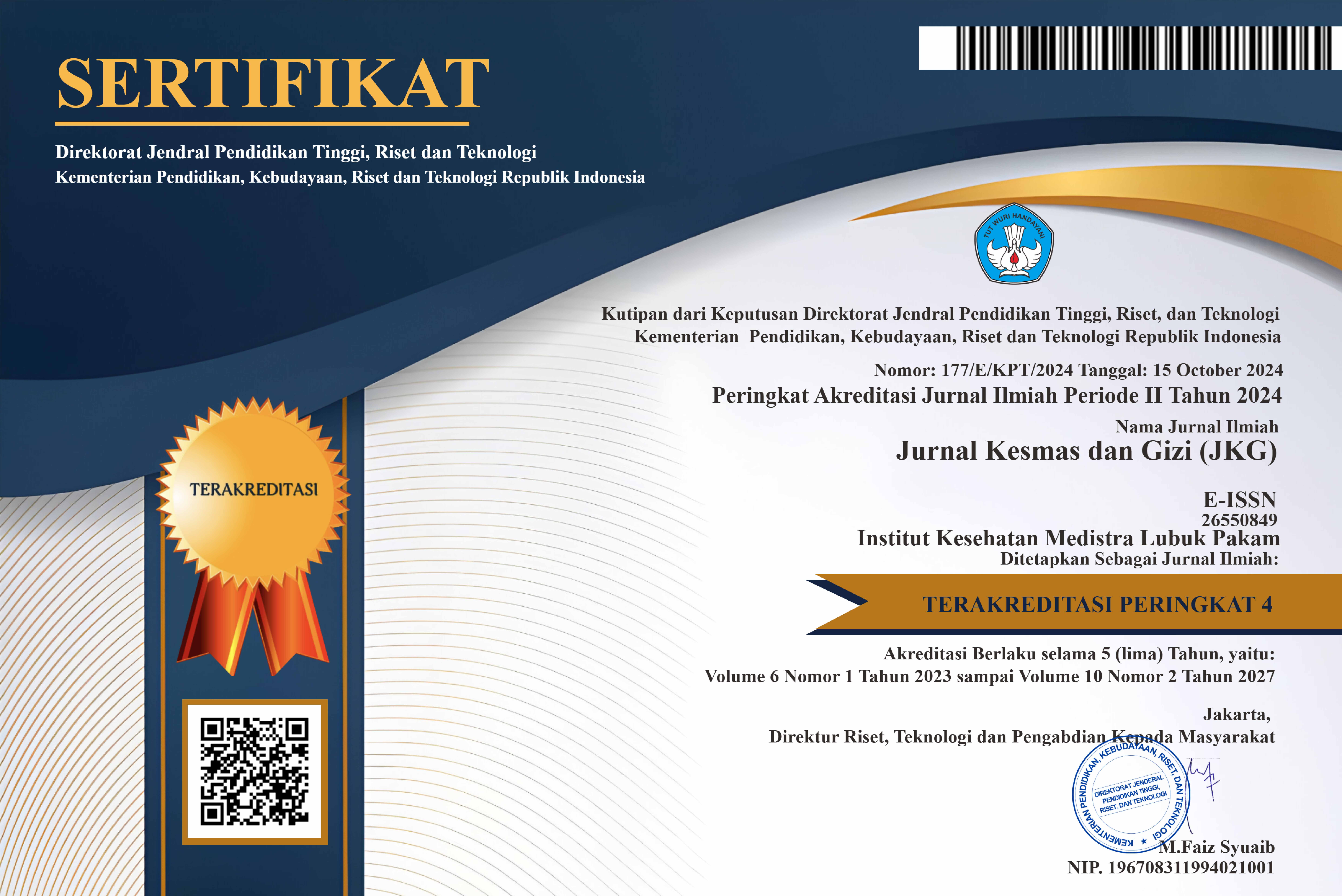Contact Dermatitis And Risk Factors Cross Sectional Study on Employees of PT Perkebunan Nusantara 1 Langsa, in Aceh, 2022
DOI:
https://doi.org/10.35451/kwkbrs65Keywords:
Contact Dermatitis, Length of Work, PPE, Personal Hygiene, Family History of AllergiesAbstract
Contact dermatitis is often associated with work and is also referred to as occupational contact dermatitis. About 90% of occupational dermatitis is contact dermatitis. This disease attacks workers who are often exposed to toxic or allergic substances, including workers in the agricultural and plantation sectors. The process of planting oil palm seeds until the harvest stage causes workers to be exposed to many chemicals in the form of pesticides, which is one of the causes of occupational skin diseases. This study aims to analyze how high the incidence of contact dermatitis is and what the risk factors are among employees of PT Perkebunan Nusantara 1 Langsa. This study is a quantitative research with a cross sectional design. The population in this study was all 47 employees of Afdelling 1 PTP Nusantara 1 Langsa, and the research sample was used as total sampling. Data collection was carried out directly by distributing observations and distributing questionnaires to employees. Then, continue with the data analysis process using the Chi Square test and logistic regression. The results showed that there were length of work (p=0.000, PR=3.4; 95% CI 2.201-5.294), use of PPE (p=0.006, PR=2.6; 95% CI 1.197-5.676), personal hygiene ( p=0.000, PR=5.2; 95% CI 1.816-14.906) and family history of allergies (p=0.000, PR=3.2; 95% CI 1.615-6.430) against contact dermatitis. Furthermore, the dominant factors related to the incidence of contact dermatitis through the binary logistic regression test were the variables length of work and personal hygiene, where length of work increased the risk of contact dermatitis 7 times and personal hygiene increased the risk of contact dermatitis 6 times.
Downloads
References
[1] I. K. Maris, “Faktor - Faktor Yang Berhubungan Dengan Dermatitis Kontak Akibat Kerja Pada Pekerja Salon Di Kecamatan Ujung Pandang Kota Makassar Tahun 2020,” Universitas Hasanuddin, 2021.
[2] A. Rahmatika, F. Saftarina, D. I. Anggraini, and D. Mayasari, “Hubungan Faktor Risiko Dermatitis Kontak pada Petani,” J. Kesehat., vol. 11, no. 1, pp. 101–107, 2020, [Online].
[3] Djuanda and Sularsito, Dermatitis dalam: Ilmu Penyakit Kulit dan Kelamin. Jakarta: Fakultas Kedokteran Univeristas Indonesia, 2017.
[4] A. Retnoningsih, “Analisis Faktor-Faktor Kejadian Dermatitis Kontak Pada Nelayan,” Universitas Muhammadiyah Semarang, 2017.
[5] Darwadi, Susmiati, and E. I. Lutfhi, “Hubungan Kontak Pupuk Urea Dengan Dermatitis Kontak Pada Petani Di Desa Sekaran Kabupaten Tuban Tahun 2017.,” J. NJS, vol. 1, no. 1, pp. 57–65, 2017.
[6] A. Djuanda, A. Suriadiredja, A. Sudharmono, B. Wiryadi, D. Kurniati, and E. Daili, Ilmu Penyakit Kulit dan Kelamin. Jakarta: Fakultas Kedokteran Universitas Indonesia, 2016.
[7] Wijaya, I. P. Iswara, I. Darmada, and L. M. M. Ruyati, “Edukasi dan Penatalaksanaan Dermatitis Kontak Iritan Kronis di RSUP Sanglah Denpasar Bali,” J. Med., vol. 5, no. 8, pp. 6–9, 2016.
[8] A. Sharma et al., “Pesticide contact dermatitis in agricultural workers of Himachal Pradesh (India).,” vol. 79, no. 4, pp. 213–217, 2018.
[9] B. Loukil, L. Mallem, and M. S. Boulakoud, “Study of Healthy Risks of Fertilizers on Biochemical Parameters in Workers,” Am. J. Toxicol. Sci., vol. 7, no. 1, pp. 22–25, 2015.
[10] Khadijah and Miko, Analisa Dermatitis Kontak pada Karyawan Semen PT Andalas Padang. Makassar: Fakultas Kedokteran Universitas Hasanudin Makassar, 2019.
[11] M. Chafidz and E. Dwiyanti, “Hubungan Lama Kontak, Jenis Pekerjaan dan Penggunaan APD Dengan Kejadian Dermatitis Kontak Pada Pekerja Tahu, Kediri,” Indones. J. Occup. Saf. Heal., vol. 6, no. 2, p. 156, 2018, doi: 10.20473/ijosh.v6i2.2017.156-165.
[12] A. Ramdani, “Hubungan antara Posisi Kerja dan Masa Kerja Terhadap Kejadian Low Back Pain Pada Penambang Belerang,” Universitas Muhammadiyah Malang, 2018.
[13] D. Saroh, Purwati, and T. Harningsih, “Description Of The Event Of Irritant Contact Dermatitis In Employees Of The Home Industry Batik,” Indones. J. Glob. Heal. Res., vol. 4, no. 3, pp. 535–542, 2022, [Online]. Available: http://jurnal.globalhealthsciencegroup.com/index.php/IJGHR
[14] Erliana, “Hubungan Karakteristik Individu dan Penggunaan Alat Pelindung Diri dengan Kejadian Dermatitis Kontak pada Pekerja Paving Block CV. Lhoksumawe,” Universitas Sumatera Utara, 2018.
[15] S. M. H. Manalu and I. Y. Nainggolan, “Personal Hygiene dan Penggunaan Alat Pelindung Diri Terhadap Gejala Dermatitis Pada Petugas Pengangkut Sampah,” J. Kesehat. Masy. Gizi, vol. 5, no. 1, pp. 102–107, 2022.
[16] M. Sholeha, R. Ena Sari, and F. Hidayati, “Faktor-Faktor Yang Berhubungan Dengan Gejala Dermatitis Kontak Pada Pemulung di TPA Talang Gulo Kota Jambi Tahun 2021,” Electron. J. Sci. Environ. Heal. Dis., vol. 2, no. 2, pp. 82–93, 2021, doi: 10.22437/esehad.v2i2.13985.
[17] Kristanti, “Hubungan Kualitas Fisik Air dan Personal Hygiene dengan Kejadian Dermatitis Kontak Alergi.,” Universitas Sumatera Utara, 2019.
[18] Jesika, “Hubungan Jenis Sumber Air Dan Personal Hygiene Dengan Kejadian Penyakit Dermatitis di Desa Kedungrangu Kecamatan Patikraja Kabupaten Banyumas,” Universitas Sumatera Utara, 2018.
[19] M. Hasanah and M. Rifai, “Hubungan Personal Hygiene Dan Penggunaan Apd Dengan Keluhan Dermatitis Kontak Pada Pembatik Warna Sintetis Di Giriloyo Kabupaten Bantul,” Hear. J. Kesehat. Masy., vol. 9, no. 1, p. 9, 2021, doi: 10.32832/hearty.v9i1.4569.
[20] Tarwoto and Wartonah, Kebutuhan Dasar Manusia dan Proses Keperawatan. Jakarta: Salemba Medika, 2020.
[21] M. Wardhana et al., “Profil dermatitis kontak akibat kerja pada pekerja garmen di Kota Denpasar,” Intisari Sains Medis, vol. 11, no. 2, pp. 517–522, 2020, doi: 10.15562/ism.v11i2.649.
Downloads
Published
Issue
Section
License
Copyright (c) 2025 Aulia Zikra, Otniel Ketaren, Janno Sinaga

This work is licensed under a Creative Commons Attribution 4.0 International License.
Copyright in each article is the property of the Author.


























